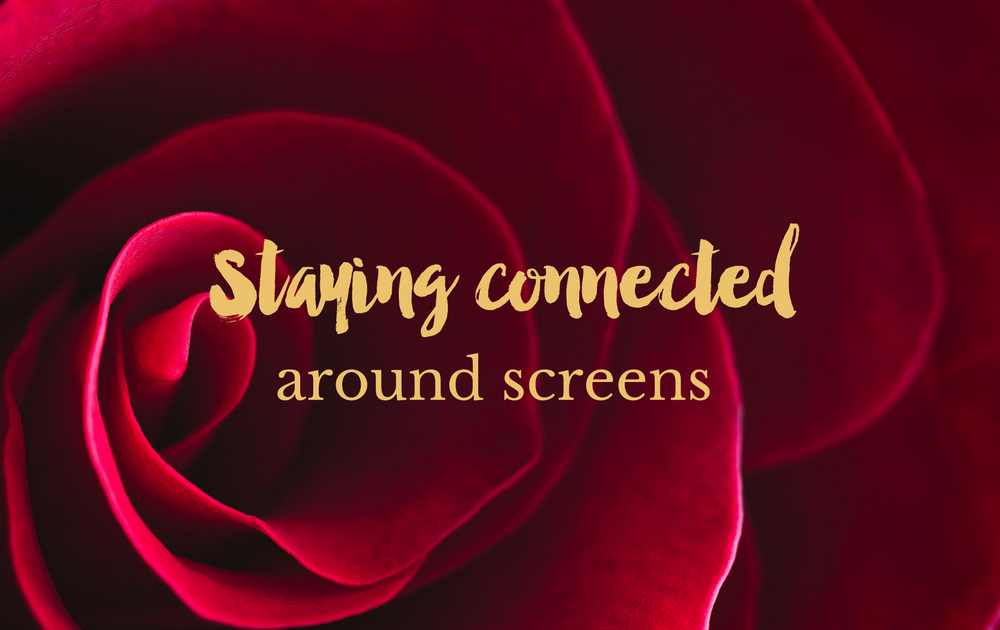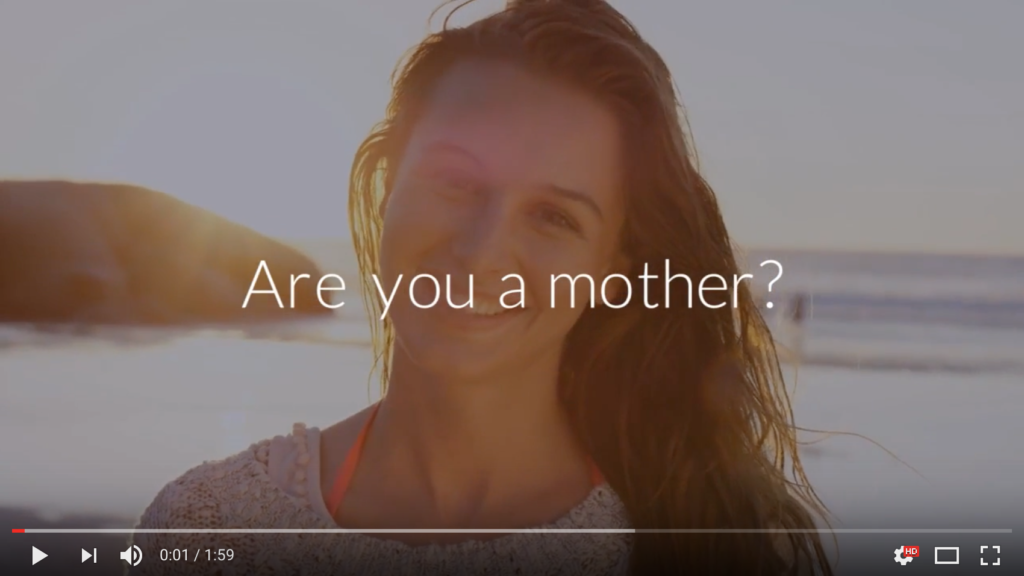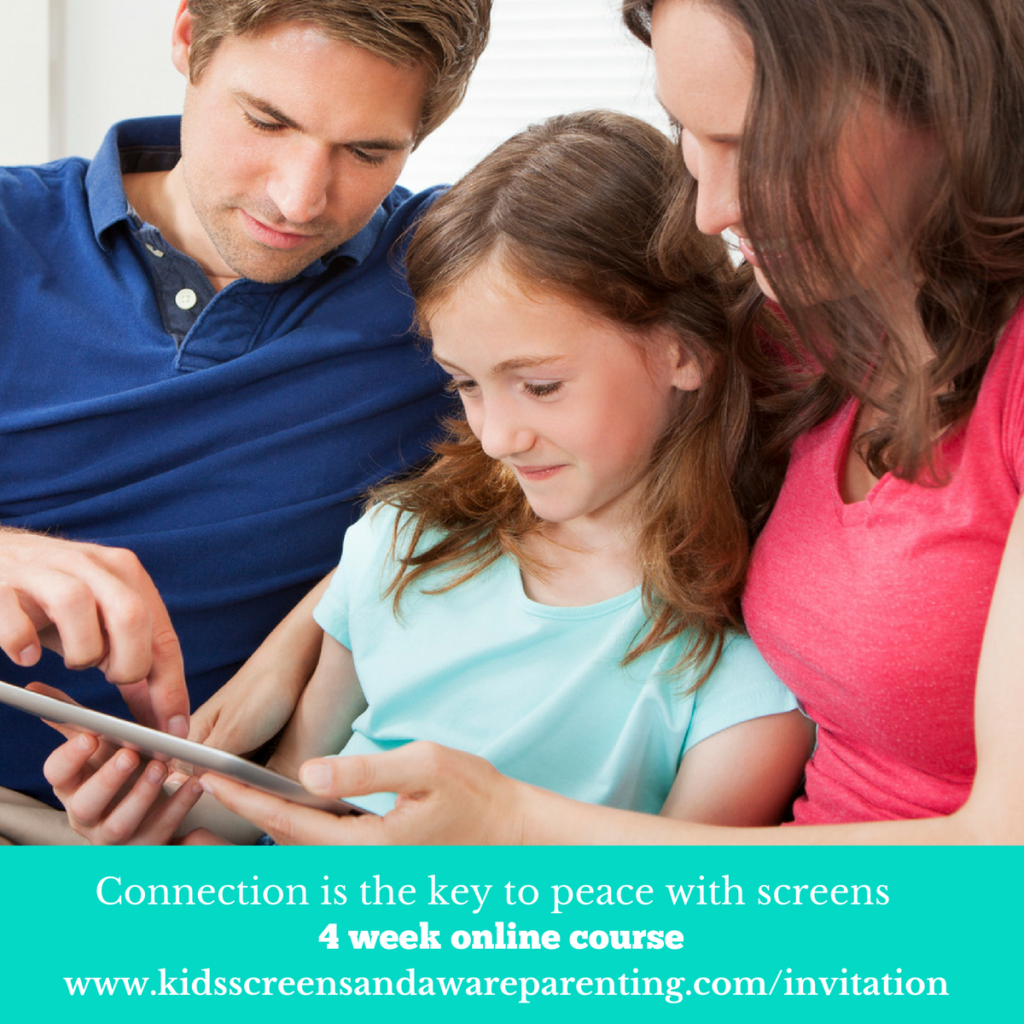Hello!
A year ago, I was still grappling with screens and my kids.
At times, they’d be looking at screens, and I’d think fearful thoughts about their future, and I’d feel scared and powerless.
That didn’t often go well, because I’d want them to get off immediately.
I’d be more connected with my fear than with my children.
Or I’d be comparing how they use screens with how other friends’ families used screens, and I’d feel deeply uncomfortable, and again, I’d respond to my children in unconnected ways, which again didn’t go well.
Basically, if I was more connected with my fear or judgement or comparison than I was with my son and daughter, the interaction with them wouldn’t look pretty.

Do you find that for yourself?
Do you find yourself worrying about your child’s future when they are looking at a screen?
Do you judge your parenting when they are watching a video?
Do you compare yourself with other families; perhaps ones who have little or no screen time, and feel uncomfortable?
Do you find yourself feeling fearful and powerless and disconnected with your child, especially when you want them to get off a screen?
It can be so easy to feel fearful around screens.
Someone shared an article with me a couple of days ago. It was entitled, “It’s ‘digital heroin’ – how screens turn kids into psychotic junkies.”
It’s easily to feel scared when reading titles like that.
And of course, we all want the best for our children. We want them to grow up engaged with others, with life, with their passions and interests.

For the last year, though, I have been at peace with screens.
A year ago I created my Kids, Screens and Aware Parenting Course (which I said I’d mention in my last letter to you.)
And I’d love to share some things with you that you might find helpful to find peace with screens, if you’re not at peace right now.

1. All screen time isn’t created equal.
I imagine you can remember times when you’ve been looking at a screen and you feel moved and touched, and you come away from it feeling inspired, having learnt new things and connected deeply to your values. I certainly have.
And I imagine at other times you’ve come away from a screen feeling flat and lacklustre and disconnected from yourself. I have too.
The difference is often the reason we choose to look at a screen in the first place.
If we go on a screen to learn something, for example to read an interesting article, or to be entertained, and we watch a comedy show, and that need is met, we can come away feeling fulfilled.
The key here is knowing WHY we are getting on, and staying connected with ourselves whilst we’re doing it.
That’s very different from feeling upset or flat and scrolling FB or watching one YouTube video after another.
When we’re not connected with WHY we’re choosing to get on a screen, then things often don’t go so well.
Tangible to-do: How would it be, if before you look at a screen, you take a few moments to connect with WHY you are going to look at it. Is it to meet a specific need? Is it to repress uncomfortable feelings?
In other words, are you doing it to connect with yourself more, or to disconnect from yourself?
When we’re following our passions, creating something, or connecting with someone important to us, or learning something we want to learn, we’re connecting with ourselves.
If we’re feeling uncomfortable feelings and we’re scrolling without aim, we’re usually disconnecting from ourselves.

2. We can aim to understand WHY our child wants to look at a screen.
When they are wanting to look at a screen, are they doing it to connect with themselves more or to disconnect with themselves?
Connection with themselves comes with looking up something they want to learn about, or following their passions, or feeling entertained, or feeling a sense of connection with who they are watching.
Disconnection with themselves comes when they are just turning on a screen for the sake of it, without aim, or because they feel upset and are trying to disconnect from the feelings.
Tangible to-do: How about connecting with what needs screens meet for your child?

3. We can tell if there’s connection or disconnection.
If you’re on a screen, and you’re feeling really interested as you’re learning something new, or you’re feeling a deep sense of connection with what you are learning, or you’re feeling moved, then you are connected with yourself.
I remember watching the last episode of “Downton Abbey”, a period drama, and being absolutely entranced – at times in tears, at times laughing out loud.
Why? Because it connected me with so many things that I care about – personal growth, feelings, motherhood, babies and children, England, understanding history, beauty, and so on.
When it had finished and I got off the screen, I felt so alive.
At other times I’ve found myself watching YouTube video after YouTube video; not connected with myself but actually wanting to avoid connection with myself, and feeling distinctly uncomfortable when I got off.
And again, it’s the same with our kids.
If they are laughing out loud, or watching something that is really important to them, or playing a game where they are creating something that’s meaningful to them, or trying to get to the next level, they are connecting with themselves.
And when they get off, we can see that difference. Are they MORE connected with themselves, or LESS connected with themselves?
Clues: if they’re happily making eye contact, smiling, sharing about what they experienced, affectionate, etc., then they are connected with themselves.
Tangible to-do: How about observing your child after they’ve been on a screen, to see if they are more or less connected with themselves after being on a screen.

4. Valuing connection with them over connection with fear, judgment and comparison.
What really helped me was to see that whenever I was in fearful thinking, judging myself or them, or comparing ourselves to other families, I had lost connection with myself and them.
And in that lost connection, I would often try to get them off screens in a disconnected way.
And that often led to more disconnection.
But once I’d done the course, and had deeply explored what needs of ours got met by screens at times, and had also explored my own childhood memories and sweet spots around screens, and explored how I could stay connected with them before, during and after screen time, I could set loving limits with those three painful ways of thinking.
I put connection first.
And I saw that I could keep on choosing connection with my children, even when they were on a screen, and even when I was wanting them to get off.
Choosing connection was the key.
And it still is.
Nowadays, if they’re on a screen, we can smile at each other, they can tell me what they’re doing, I can see them laughing out loud, and we can all stay connected DURING screen time.
Without believing fearful, judgmental or comparative thoughts, I’m free to stay connected with myself and with them.
Tangible to-do: How about setting loving limits with fearful, judgmental or comparative thoughts around screens, and choose connection instead?

5. I prioritise observing them.
Before, if I was entertaining fearful thoughts, judging myself or them, or comparing us, I really wasn’t actually observing them and what was really going on in the present moment.
Nowadays, I observe them.
I see them laughing and smiling on screens.
I see them chatting away together when they’re playing a game together on a screen.
I listen to them telling me all about what they’ve just been doing on a screen, or see them smiling with joy as they remember what they’ve been doing, afterwards.
And if I see something different – if I see them looking upset and THEN wanting to go on a screen, then I go for connection.
I’m responding to what is, rather than what fearful thoughts might be.
Tangible to-do: How about really focussing on observing your child before, during and after their screen time. What do you see?

So, how are things different now?
Well, CONNECTION is the top priority.
I make sure I’m connected with my kids even when they’re on a screen.
That starts with my choice to choose love over fear.
That means I’m mostly close to them when they’re on a screen.
That involves me looking at them, responding to them, going to them and smiling at them or touching them warmly whilst they’re on a screen.
That means I keep connected to my choice for connection and love with them, EVEN when they’re on a screen, and EVEN when they want to stay on and when I would prefer that they get off.
That includes me tuning in to their experience, their needs, their values, and understanding things from their perspective.
And I feel such RELIEF at being so at peace with screens, because I remember how much turmoil I used to be in, and how that turmoil would often lead to me acting in ways I didn’t want to with my kids, leading to DISCONNECTION.
Prioritising CONNECTION and LOVE made all the difference.

I wonder if any of this resonates for you?
And if so, are there any tangible, concrete steps you’d like to take so that you feel more at peace with screens?
I believe that each family is unique, and each family’s screen use is unique.
But we can only find out what that is by LISTENING to ourselves and OBSERVING and LISTENING to our children.
As I mentioned in my last letter, I made a little free intro. course on this, which you can access by clicking HERE or on the meme below.
I also made a two minute video about it, which you can watch by clicking on the video below.
And if you’d like to explore this more deeply;
looking in detail about what needs of yours and your child’s get met by screens,
exploring old sweet spots and painful thoughts,
and finding ways to stay connected before, during and after screen time,
then the four week course is open for you anytime you want.
You can find out more by clicking HERE or on the image below.
Love,
Marion



